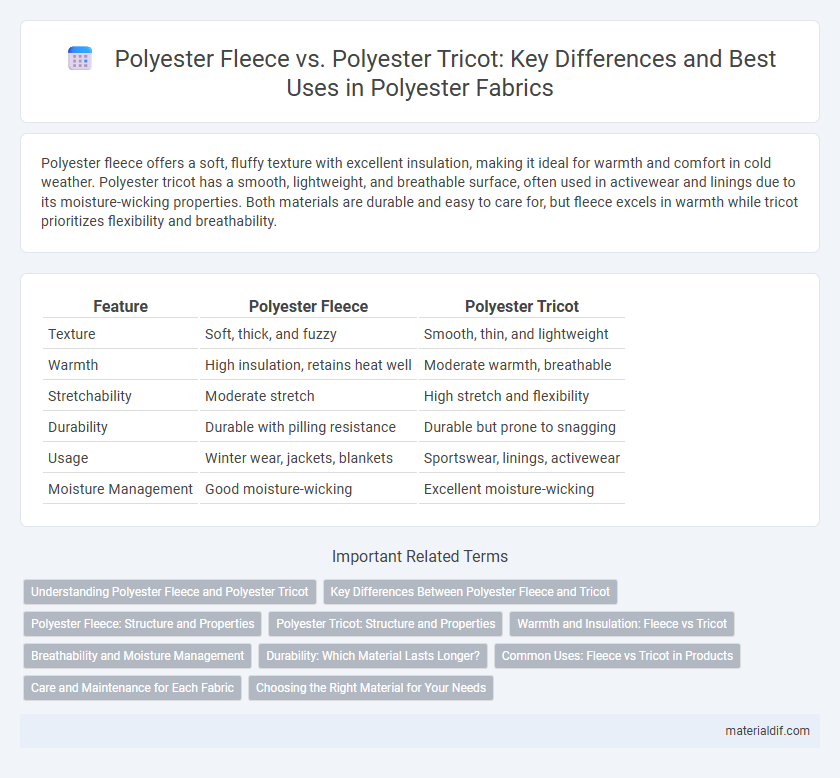Polyester fleece offers a soft, fluffy texture with excellent insulation, making it ideal for warmth and comfort in cold weather. Polyester tricot has a smooth, lightweight, and breathable surface, often used in activewear and linings due to its moisture-wicking properties. Both materials are durable and easy to care for, but fleece excels in warmth while tricot prioritizes flexibility and breathability.
Table of Comparison
| Feature | Polyester Fleece | Polyester Tricot |
|---|---|---|
| Texture | Soft, thick, and fuzzy | Smooth, thin, and lightweight |
| Warmth | High insulation, retains heat well | Moderate warmth, breathable |
| Stretchability | Moderate stretch | High stretch and flexibility |
| Durability | Durable with pilling resistance | Durable but prone to snagging |
| Usage | Winter wear, jackets, blankets | Sportswear, linings, activewear |
| Moisture Management | Good moisture-wicking | Excellent moisture-wicking |
Understanding Polyester Fleece and Polyester Tricot
Polyester fleece is a soft, insulating fabric made from knitted polyester fibers designed to trap heat and provide warmth, commonly used in outerwear and cold-weather apparel. Polyester tricot is a lightweight, smooth, and durable warp-knitted fabric popular for activewear, linings, and sportswear due to its breathability and stretch. Understanding the differences in texture, weight, and thermal properties between polyester fleece and polyester tricot helps determine the ideal fabric choice for specific clothing applications.
Key Differences Between Polyester Fleece and Tricot
Polyester fleece features a soft, plush texture with excellent insulation and moisture-wicking properties, making it ideal for cold-weather apparel and blankets. In contrast, polyester tricot has a smooth, stretchy surface with a tighter knit, offering lightweight breathability and durability suited for activewear and linings. Key differences include fleece's warmth retention and bulkiness versus tricot's sleekness and moisture management in high-performance garments.
Polyester Fleece: Structure and Properties
Polyester fleece features a soft, brushed surface created by knitting polyester fibers into a dense pile fabric, providing excellent insulation and moisture-wicking properties. Its structure consists of tightly knit loops that trap air, enhancing thermal retention while maintaining breathability. The fabric's durability, lightweight nature, and resistance to shrinking and stretching make it ideal for activewear and cold-weather clothing.
Polyester Tricot: Structure and Properties
Polyester Tricot features a warp-knit construction that creates a smooth, fine-textured fabric known for its elasticity and durability. Its lightweight, breathable structure allows for excellent moisture-wicking properties, making it ideal for activewear and linings. Unlike the thicker, fuzzy surface of polyester fleece, polyester tricot offers a sleek finish with superior resistance to pilling and snagging.
Warmth and Insulation: Fleece vs Tricot
Polyester fleece offers superior warmth and insulation due to its thick, napped texture that traps heat effectively, making it ideal for cold-weather apparel. In contrast, polyester tricot features a smooth, lightweight knit with less thermal retention, providing moderate warmth but greater breathability. The fleece's dense fibers create an insulating layer that outperforms tricot's thinner, less insulating fabric in retaining body heat.
Breathability and Moisture Management
Polyester fleece offers superior warmth and insulation with moderate breathability, making it ideal for cold-weather activities requiring moisture retention. Polyester tricot fabric features a tighter knit that enhances breathability and moisture-wicking capabilities, promoting quicker drying and better ventilation during high-intensity workouts. Both fabrics excel in moisture management, but polyester tricot outperforms fleece in maintaining dryness and airflow.
Durability: Which Material Lasts Longer?
Polyester fleece offers superior durability due to its thick, brushed surface that resists pilling and wear over time, making it ideal for heavy-use apparel and outdoor gear. Polyester tricot, while smooth and lightweight, is less durable because its thin knit structure is more prone to snagging and abrasion. Therefore, polyester fleece generally lasts longer in demanding conditions compared to polyester tricot.
Common Uses: Fleece vs Tricot in Products
Polyester fleece is commonly used in outdoorwear, blankets, and activewear due to its warmth, softness, and insulating properties. Polyester tricot, characterized by its smooth texture and lightweight feel, is frequently found in linings, lingerie, and sportswear where breathability and flexibility are essential. Both fabrics serve distinct purposes; fleece provides thermal insulation, while tricot excels in moisture management and stretchability for comfort.
Care and Maintenance for Each Fabric
Polyester fleece requires gentle washing in cold water and air drying to preserve its softness and prevent pilling, while avoiding fabric softeners that can reduce its insulating properties. Polyester tricot is more durable with easy machine washing in warm water and low heat drying, maintaining its smooth texture and resistance to wrinkles. Proper care for each fabric extends the lifespan and retains the fabric's unique characteristics, ensuring optimal performance in apparel and activewear.
Choosing the Right Material for Your Needs
Polyester fleece offers superior warmth and softness, making it ideal for cold-weather clothing and cozy blankets, while polyester tricot provides lightweight breathability and smooth texture, perfect for activewear and linings. Selecting the right material depends on your specific use case: fleece suits insulation needs, whereas tricot enhances moisture management and flexibility. Consider durability requirements and comfort preferences to optimize performance in your textile applications.
Polyester Fleece vs Polyester Tricot Infographic

 materialdif.com
materialdif.com